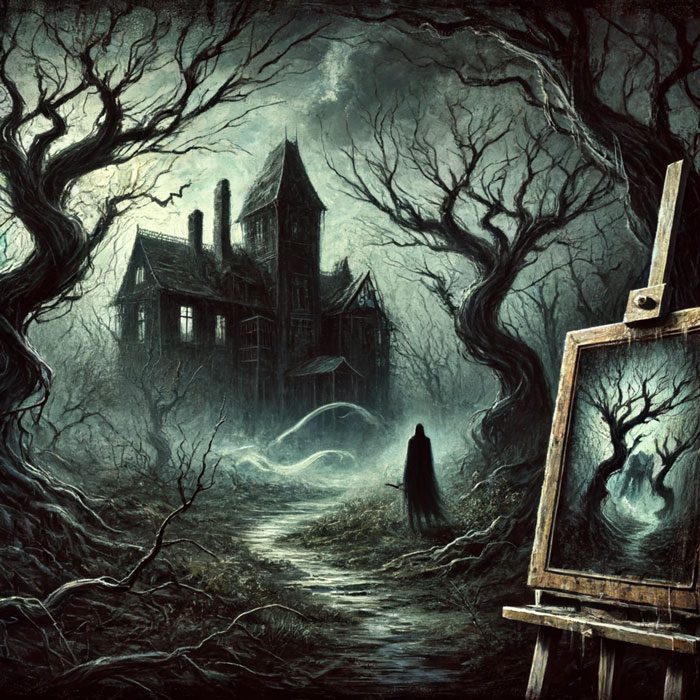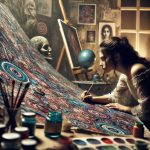
Why are we so fascinated by the macabre in art? From grotesque paintings to chilling films, horror has a long-standing place in the art world. What drives our morbid curiosity? This article dives into the psychology behind horror in art, unraveling the reasons why we are drawn to the eerie and the unsettling.
The Allure of Horror: Psychological Triggers
Fear is one of our most basic survival mechanisms. It’s hardwired into our brains, designed to keep us safe from danger. The amygdala, a small almond-shaped cluster of nuclei deep within the brain, is responsible for processing fear and preparing our bodies to respond to threats. This primal reaction can be triggered by horror art, making us feel a rush of adrenaline and heightened alertness, similar to the response our ancestors would have had when encountering a predator.
Experiencing horror can also serve as a form of catharsis. In psychology, catharsis refers to the process of releasing, and thereby providing relief from, strong or repressed emotions. Horror art offers a safe space to confront our deepest fears and anxieties. By engaging with frightening imagery in a controlled environment, we can process and manage our fears, leading to emotional release and a sense of relief.
Curiosity about the unknown plays a significant role in our attraction to horror. Humans have an innate desire to explore and understand the world around them, including its mysteries and dangers. Horror art taps into this curiosity, presenting us with scenarios that are both fascinating and terrifying. The thrill of peeking into the abyss, so to speak, satisfies our need to confront and make sense of the unknown.
Another psychological trigger is the enjoyment of controlled fear. Just like riding a roller coaster, engaging with horror art allows us to experience fear without actual danger. This controlled environment can be exhilarating, providing a rush of excitement and a unique form of entertainment. The safe distance between us and the horror depicted in art allows us to enjoy the experience without real-world consequences.
Historical Context of Horror in Art
Horror in art has ancient roots, dating back to early human history. Cave paintings from tens of thousands of years ago depict terrifying beasts and scenes of danger, reflecting the fears and threats faced by early humans. These early artworks served not only as storytelling tools but also as warnings and lessons for survival. Similarly, medieval art is rife with images of demons, hell, and the grotesque, illustrating the spiritual and existential fears of the time.
The Gothic era marked a significant development in horror art. This period saw the rise of gothic literature and art, characterized by dark, mysterious, and supernatural themes. Authors like Mary Shelley and Edgar Allan Poe created works that delved into the macabre, exploring themes of death, madness, and the supernatural. Gothic architecture, with its towering spires and gargoyles, also reflected this fascination with the eerie and the sublime.
Moving into the 20th and 21st centuries, horror in art evolved alongside societal changes and technological advancements. The Surrealist movement, led by artists like Salvador Dalí, introduced new ways to explore the subconscious and the uncanny. Dalí’s melting clocks and dreamlike landscapes tapped into the surreal and the bizarre, challenging viewers to confront their inner fears and anxieties. Modern horror films, with their special effects and psychological depth, have also pushed the boundaries of what horror art can achieve.
The impact of historical events on horror art cannot be understated. Wars, pandemics, and political turmoil have all influenced the themes and styles of horror art throughout history. For example, Francisco Goya’s series of prints, “The Disasters of War,” depicted the brutal realities of the Peninsular War, using graphic and disturbing imagery to convey the horrors of conflict. These works not only reflected the artist’s personal trauma but also served as a powerful critique of war and violence.
Cultural Significance and Social Commentary
Horror art often mirrors societal anxieties and cultural fears. During times of social upheaval, economic instability, or political unrest, horror themes tend to become more prominent. This is because art, in general, is a reflection of the collective consciousness, and horror art, in particular, can tap into the underlying fears and uncertainties of a society. For example, the rise of zombie movies in the late 20th and early 21st centuries has been interpreted as a reflection of fears about disease, overpopulation, and societal collapse.
Artists frequently use horror as a tool for social critique. By depicting grotesque and unsettling imagery, they can draw attention to societal issues and injustices. Francisco Goya’s “The Disasters of War” series is a prime example of this. Goya used horrifying scenes of violence and suffering to comment on the atrocities of war, challenging viewers to confront the brutal realities of human conflict. Similarly, modern artists have used horror to address issues such as gender violence, environmental destruction, and political corruption.
Horror art can also subvert expectations and provoke thought. By presenting familiar subjects in unsettling ways, artists can challenge viewers’ perceptions and encourage them to think critically about the world around them. For instance, feminist horror art often subverts traditional representations of women, using horror imagery to explore themes of empowerment, identity, and resistance. This approach not only shocks and unsettles but also inspires reflection and dialogue.
The cultural significance of horror art extends beyond its immediate impact on viewers. Horror has the power to shape and influence cultural norms and values. By confronting taboo subjects and exploring the darker aspects of human experience, horror art can push the boundaries of what is considered acceptable or normal. This, in turn, can lead to broader cultural shifts and changes in societal attitudes towards fear, violence, and the unknown.
The Neuroscience of Horror Art
The brain’s reaction to horror is both fascinating and complex. When we encounter frightening imagery, our brain triggers the fight-or-flight response, preparing our bodies to either confront or escape the perceived threat. This response involves the release of adrenaline and other stress hormones, which heighten our senses and increase our heart rate. Even though we know the horror is not real, our brain reacts as if it is, creating a thrilling and immersive experience.
Dopamine, the neurotransmitter associated with pleasure and reward, also plays a role in our reaction to horror. When we experience controlled fear, such as watching a horror movie or viewing a disturbing piece of art, our brain releases dopamine, which can create a sense of euphoria. This pleasure-fear connection explains why some people enjoy horror despite the fear it induces. The rush of dopamine makes the experience exhilarating and enjoyable.
Specific visual and auditory elements in horror art are designed to elicit strong emotional reactions. Dark, shadowy images, sudden movements, and eerie sounds can all trigger the brain’s fear response. Artists and filmmakers use these elements strategically to create tension and suspense. For example, the use of chiaroscuro, a technique that contrasts light and dark, can create a sense of unease and highlight the macabre details in a painting or scene.
The way horror art manipulates our senses is a testament to the power of visual and auditory stimuli in evoking emotions. The brain processes visual information in a way that can amplify the impact of disturbing imagery. Similarly, sound can enhance the emotional experience of horror. Creepy music, sudden loud noises, and unsettling soundscapes can all heighten our sense of fear and immersion. This multi-sensory approach makes horror art a powerful tool for evoking emotional and psychological responses.
Horror in Contemporary Art and Media
Horror has a prominent place in contemporary fine art. Many modern artists are known for their horror-themed work, which often explores complex psychological and existential themes. H.R. Giger, for instance, is famous for his biomechanical art, which combines human and machine elements in unsettling ways. Giger’s work, which includes the design of the creature in the film “Alien,” evokes a sense of unease and fascination, exploring themes of transformation and the unknown.
Contemporary horror extends beyond fine art to popular culture, with horror movies, TV shows, and video games captivating audiences worldwide. Films like “The Exorcist” and “Silent Hill” have left lasting impacts on the genre, influencing countless other works and shaping the public’s perception of horror. These media forms use advanced special effects, immersive storytelling, and psychological depth to create compelling horror experiences that resonate with audiences.
Digital and interactive media are transforming the experience of horror. Virtual reality (VR) horror experiences, for example, place viewers directly into terrifying scenarios, making the fear more immediate and intense. Interactive horror installations and escape rooms also provide immersive, hands-on experiences that challenge participants to confront their fears in real-time. These innovations are pushing the boundaries of horror art, creating new ways for audiences to engage with the genre.
The influence of horror in contemporary media underscores its enduring appeal and versatility. Whether through traditional fine art, films, or digital experiences, horror continues to captivate and challenge audiences. Its ability to evoke strong emotional reactions and provoke thought makes it a powerful and relevant form of artistic expression in the modern world.
The Appeal and Impact of Horror Art on Audiences
Personal stories and testimonials reveal the deep and varied impact horror art can have on individuals. Many people find that engaging with horror helps them confront and manage their own fears and anxieties. For some, it offers a way to process trauma and gain a sense of control over their emotions. Others simply enjoy the thrill and excitement that horror art provides, finding it a unique form of entertainment and escape.
Research suggests that experiencing horror can have positive psychological effects. Studies have shown that watching horror movies or engaging with horror art can increase resilience and stress tolerance. By exposing themselves to controlled fear, individuals can become better equipped to handle real-life stressors and challenges. This process, known as “stress inoculation,” helps build emotional strength and coping skills.
However, there are potential downsides to consuming horror. Some individuals may experience negative psychological effects, such as desensitization to violence or recurring nightmares. It’s important to recognize and balance the impact of horror art on mental health. Moderation and self-awareness are key to ensuring that the experience remains positive and enriching. For those who find horror art distressing, it may be best to limit exposure and seek out other forms of entertainment.
Despite these potential drawbacks, the overall appeal of horror art is undeniable. Its ability to evoke strong emotions, stimulate curiosity, and provide cathartic release makes it a compelling genre for many. By understanding the psychological mechanisms behind our fascination with horror, we can appreciate its significance and impact more deeply. Whether you’re a fan of classic horror films or contemporary horror art, there’s no denying the power and allure of the macabre.
Conclusion
The psychological reasons behind our fascination with horror in art are multifaceted and deeply rooted in our human experience. From evolutionary survival mechanisms to the thrill of controlled fear, horror art taps into fundamental aspects of our psyche. Its historical evolution and cultural significance reflect the ever-changing landscape of human fears and anxieties, while its impact on audiences underscores its enduring appeal.
As we continue to explore and engage with horror art, it remains a powerful tool for emotional release, social critique, and cultural reflection. Whether you’re peering into the dark corners of a gothic painting or immersing yourself in a VR horror experience, the journey into the macabre is both fascinating and revealing. So, next time you find yourself drawn to the eerie and unsettling, remember that you’re not alone—it’s all part of the human experience.
What are your thoughts on horror in art? Do you find it thrilling or terrifying? Share your experiences and favorite horror artworks in the comments below. And don’t forget to check out our other articles on the fascinating world of art and design.




